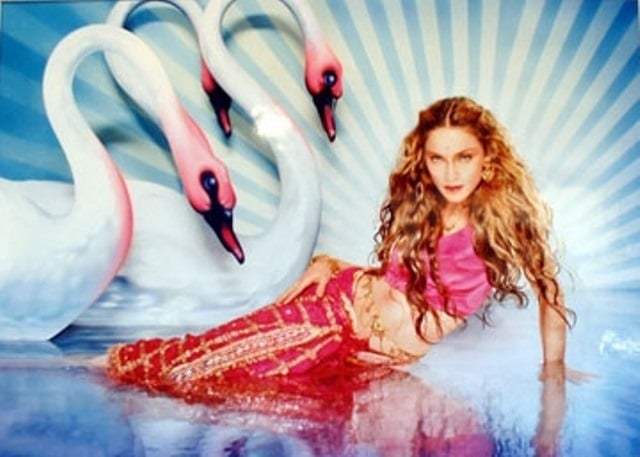
Photo: courtesy Pink Shrimp Fine Art
Bright, uplifting, sexy, and brilliant—David LaChapelle’s work is highly prized in a culture obsessed with all things Pop. His career has been characterized by a boomerang-like trajectory, beginning in a contemporary art mileu and blossoming into commercial success, only to find its way back to where it started.
Since he returned to exhibiting his work in a fine art context in the late aughts, LaChapelle has had a slew of gallery shows. Currently you can see his color-soaked work in person at “PIPE DREAM – Araki, LaChapelle, Molinier, Newton, Pierre Gilles” through February 19, 2016, at Galerie Andrea Caratsch in Zurich.
LaChapelle grew up in Connecticut, and grew up fast. By the age of 14, he was already travelling into New York to go dancing in nightclubs, and by the following year he had moved to New York and was working as a bus boy at the infamous Studio 54.
Nevertheless, he and his parents agreed he would return home to finish high school at the North Carolina School of Arts, where he discovered photography—and instantly knew it was what he wanted to do with his life.
At 17, LaChapelle was back in New York and began associating with Andy Warhol, who famously offered him a job at Interview Magazine.
David LaChapelle, Last portrait of Andy Warhol
Photo: courtesy Artificial Gallery
Working for Interview Magazine, the young photographer enjoyed shooting a variety of famous subjects, ranging from the Beastie Boys’s first shoot to Andy Warhol’s last. His work attracted a lot of attention, and soon he was shooting for other prestigious publications such as Vogue Italia, Rolling Stone, and Vanity Fair.
In 1984, LaChapelle had two solo exhibitions in New York. “Good News for the Modern Man” was at a friend’s loft, and “Angels, Saints and Martyrs” took place at Lisa Spellman’s 303 Gallery. He was heavily involved in the contemporary art scene at the time, mixing with the likes of Keith Haring and Jean-Michel Basquiat.
His early fine art work contains traces of the hyper-real iconographic imagery found in his later work, but it was the commercial aspect of LaChapelle’s photography that initially launched his career.
David LaChapelle Pamela Anderson: Faster, Faster, I Am Almost There (1996–2001)
Photo: courtesy Jablonka Maruani Mercier Gallery
Working in his signature pop-surrealist style, LaChapelle created layered, dramatic portraits and fashion editorials, often involving intricate sets and expensive props. The effect was immediately iconic and became highly sought-after, and by the the early 90s, LaChapelle was photographing the biggest starts on the planet, such as Michael Jackson and Madonna.
He has said since that his uplifting, colorful style was born as his friends began to die from AIDS in the 1980s, making him want to focus on creating beautiful things.
“My love is the still image, creating these scenes, or creating these tableaux and stories or narratives where you’re reaching people through an image,” he said in a Vice documentary. “That’s my love: the power that’s within that still image”
David LaChapelle Mythical Swans: Madonna, New York, Rolling Stone (1988)
Photo: courtesy Pink Shrimp Fine Art
During the mid 90s, LaChapelle was working continuously, and was so well-regarded one magazine called him “the Fellini of photography.” He then began to branch off into time-based work, making music videos for a huge range of artists including Kelis, Christina Aguilera, Amy Winehouse, and Moby. His videos all bear the same signature style of saturated color and a “super-real” aesthetic.
David LaChapelle Kanye West: Passion of the Christ (2006)
Photo: Jablonka Maruani Mercier Gallery
Following the success of his video work, LaChapelle moved into feature film. He first made the Sundance-Awarded short, Krumped (2004), and followed that success with Rize (2005), a critically acclaimed documentary on the “krumping” style of street dance.
But in 2006, the hard-working LaChapelle abruptly left the business and moved to Hawaii to live in seclusion, citing exhaustion. He had reached a bit of a breaking point, and it was unsure when or if he’d return to his prolific output. After a few years, a friend suggested that he could exhibit fine art photographs again.
David LaChapelle Gas Chevron (2012)
Photo: courtesy Galerie Daniel Templon
LaChapelle has since compared the experience of returning to fine art photography to being reborn.
The subject matter in LaChapelle’s fine art work varies widely, from stylized still lives mixing art history with modern paraphernalia, to hyper-real landscapes blending urban and suburban environments. His exhibition “LAND SCAPE” at Paul Kasmin in 2014 sought to highlight ecological concerns. “When I was young, we didn’t think about the end of human existence,” LaChapelle told Interview Magazine. “We didn’t think about the end of existence at our own hand, with just living. I can’t see 20 years from now, us going along with the way things are today.”
LaChapelle has lived a fascinating life, coming of age during an era in New York that holds a great fascination for many. His transporting aesthetic has always been and will likely always be popular—but perhaps more so than fame and popularity, it will be interesting to see how his work matures, as LaChapelle gets older and, and like many of us, more worried.